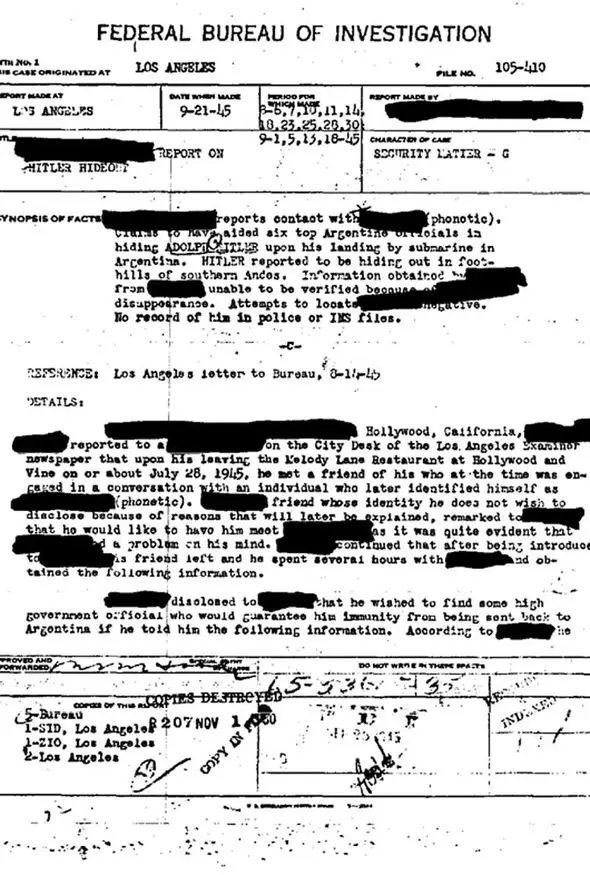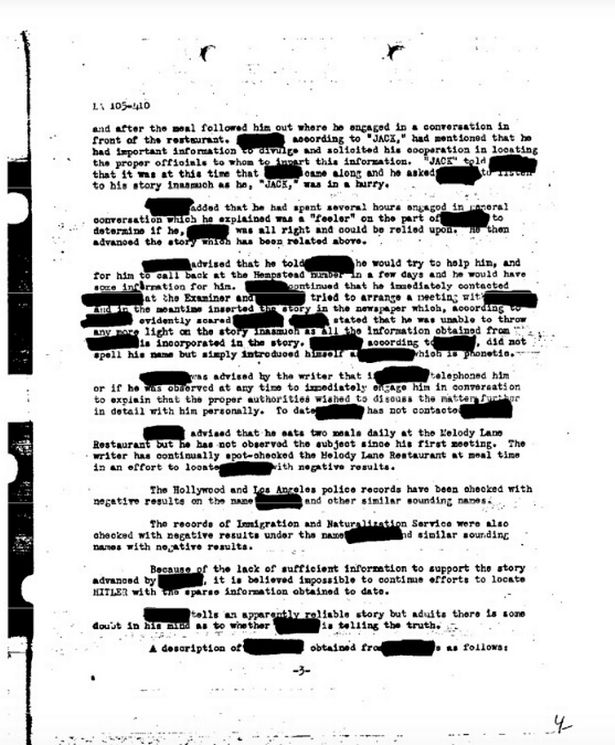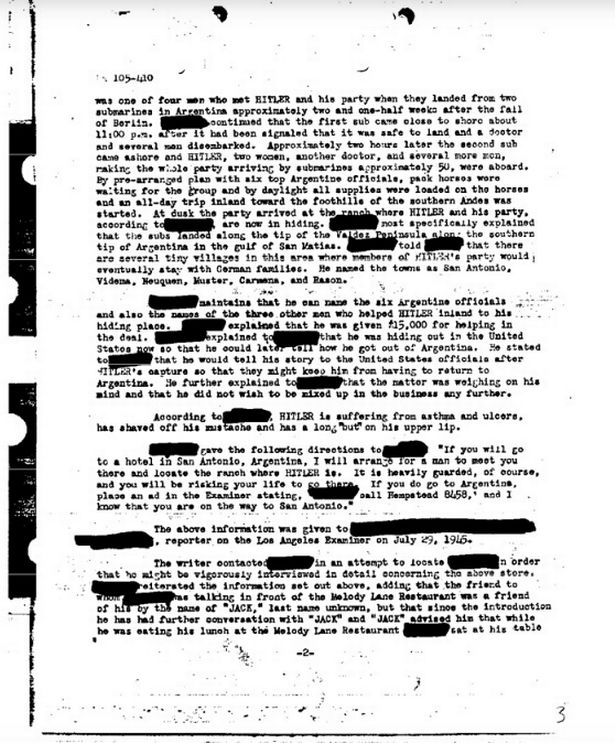Some Background:
So, It's the 1930's. Hitler is coming to power in Germany. He's plotting to take over the world
any way he can. Him and his Generals and doctors and others are making plans for war.
Everybody, believes that Hitler died by committing suicide in his bunker in 1945. BAH - HUMBUG!
Hitler and his men had ten years, not including the war years to plan an escape route just in case
Germany fell.
The following articles, while not proof that Hitler escaped to Argentina post World War II should at least
make you wonder. What If!
Read the articles. Look at the pictures and you decide.
Erich Priebke, a former SS captain
This article is taken from the New York Times - 1995
Nestled in Argentina's snow-capped Andes, overlooking a vast pristine lake, this picturesque
ski town has long been a favorite of Latin American jet-setters. No wonder it was chosen as
the site for the recent annual meeting of presidents from Spanish- and Portuguese-speaking
countries.
But despite Bariloche's many gingerbread houses, chocolate and fondue shops, pine forests
and jagged peaks, which have led many visitors to compare it to Bavaria, the town's
reputation has been undermined by an 82-year-old former Nazi who has become its most
infamous resident.
Erich Priebke, a former SS captain who has lived in Bariloche for 50 years and has admitted
taking part in the killings of 335 Italian civilians at the Ardeatine Caves outside
Rome in 1944, is under house arrest here as the Argentine Supreme Court decides whether
he will be extradited to Italy.
For decades Argentines have quietly referred to Bariloche as a haven for Nazis who fled
Germany after World War II. But it was not until two years ago, when Mr. Priebke was
uncovered by a team from ABC News television, that the world began to associate this
town with Nazis.
"You'd have to be either crazy or blind and deaf to think that Bariloche does not have
its share of Nazis," said Rosario Zaballa, 48, a store clerk who has lived here all
her life. "They don't bother anybody, but they are here."
Swastikas are regularly scrawled on walls and even appear in some public artwork.
Throughout the town, people tell tales of Germans who still hold secret celebrations
of Hitler's birthday on April 20.
Many residents openly support Mr. Priebke. He declined to be interviewed but has said
he is innocent of any crime because he was obeying Hitler's orders.
The Italian massacre, which included 71 Jewish victims, was ordered by the SS in
reprisal for an attack by Italian underground fighters that killed 33 German soldiers.
In August, an appeals court overturned a lower court judgment ordering the extradition of
Mr. Priebke to Italy. His lawyer, Pedro Bianchi, told reporters here that the decision
was based on Argentina's 15-year statute of limitations for murder.
A group of Mr. Priebke's supporters held a Mass to celebrate the court's ruling, and a
local newspaper, Bariloche Hoy, said in a front-page article that Mr. Priebke was
"an ideologically responsible person" and not guilty of the Nazi atrocities.
To many Jews, the appeals court's decision is another example of how Argentina continues
to provide refuge for Nazis.
"We have his signed confession that he participated in these acts, and I can't understand
why the court would refuse to extradite him," said Rabbi Marvin Hier, dean of the Los
Angeles-based Simon Wiesenthal Center, which is devoted to bringing Nazis to justice.
"There is a great support in Argentina for fascism and people who love the old days under
Peron when people like Priebke were heroes," Rabbi Hier said. "What the Argentine Government
really wants is a biological solution to the problem. That Priebke will die before they have
to extradite him."
President Carlos Saul Menem's Government has said it is committed to bringing former Nazis
living in Argentina to justice, including quick extraditions.
Tourism and municipal government officials, who spoke on condition of anonymity, said people
who believe that Bariloche is a Nazi refuge are judging the city unfairly, based solely on
the past actions of a small fraction of its residents.
The officials said Bariloche, about 850 miles southwest of Buenos Aires, was one of the few
cities in Argentina that had passed a resolution repudiating Nazism and noted that the city's
three other papers had called for Mr. Priebke's extradition.
Bariloche, a town of more than 100,000 people that was founded 100 years ago by Germans
from Chile, today has a German population of several hundred.
Daniel Reisfeld, a retailer who is president of Bariloche's small Jewish population of
35 families, said that while he had not encountered any anti-Semitism in the 15 years he
has lived in Bariloche, he believed there were anti-Semites and Nazis living here.
"There is the same quantity, percentage-wise, of Nazis living in Bariloche as there is
in any other city with a strong German population and history," Mr. Reisfeld said.
"The only difference is that Bariloche is the only city with a Nazi who is waiting to
be extradited and who has caught people's attention."
In the years that followed the exposure of Priebke’s criminal past, he was extradited
to Italy, tried, and eventually sentenced to life imprisonment in 1998. Due to his
age and ill health, however, he remained under house arrest until his death in 2013
at the age of 100. He had requested his remains to be returned to Argentina so he
could be buried with his wife; the request was denied by the Argentinian government,
and instead the Italian authorities buried him in a secret location.
A version of this article appears in print on Oct. 30, 1995, Section A, Page
4 of the National edition with the headline: San Carlos de Bariloche
Journal;In Nazi's Hiding Place, the Stain Won't Wash Away.
Nazis in Bariloche
These are other Nazi's reported to be in or lived in Bariloche
Reinhard Kopps (29 September 1914 Hamburg – 11 September 2001 Bariloche, Argentina)
was an SS Officer for the Nazi Party during World War II. Following the defeat of
Germany in World War II, he helped Nazis escape to Argentina, finally fleeing there
himself. Under the assumed name of Juan Maler, Kopps was hiding in the small town of
Bariloche in the Andes Mountains. Bariloche was the home of many Germans after World
War II
Recently opened Nazi archives in 1994 caused ABC News to research Nazi war criminals.
After research revealed many Nazis living in Argentina, Sam Donaldson confronted Maler
on camera,[1] getting him to admit that he was Reinhard Kopps, a former Nazi, and that
he assisted Nazis to leave Germany and settle in Argentina. In order to deflect
attention away from himself, he told Donaldson that an even worse war criminal,
Erich Priebke, was also living there, confirming ABC News research. Priebke was soon
arrested, and Kopps fled. The story was made for ABC's Primetime Live, as well as Nazi
Hunters. He died a free man in 2001.
In his 2004 book Bariloche nazi-guía turística, Argentine author Abel Basti claims
that Adolf Hitler and Eva Braun lived in the surroundings of Bariloche for many
years after World War II.[6][7] Basti said that the Argentine Nazis chose the estate
of Inalco as Hitler's refuge.[
Frederic Lantschner was a Nazi governor of Tyrol in Austria. He fled to Bariloche in
1948, where he set up a construction company, using the letters ‘SS’ for its emblem,
and joined the mountaineering society Club Andino Bariloche, of which Priebke was
also a member. He died a free man in Bariloche.
Josef Mengele was a Nazi officer and physician known as the “Angel of Death” for
his role in conducting deadly human experiments. He was sheltered in Bariloche,
and took his driving test outside the Town Hall. He fled the city as the Israeli
intelligence agency Mossad closed in on him. In 1979, he was found drowned on a
beach in Brazil.
Hans-Ulrich Rudel was a high-ranking Nazi ground pilot, one of Hitler’s close
confidants and the most decorated German serviceman of World War II. In exile
in Bariloche, he founded a relief organisation for Nazi criminals, helping them
escape to South America and the Middle East. He later moved to Paraguay and then
back to Germany, where he represented the neo-Nazi German People’s Union. He died
in West Germany in 1982.
Josef Scwammberger was an SS commander in forced labour camps in Poland.
He escaped to Bariloche in 1948, where he lived briefly in a lodge with his family.
In 1987, he was extradited to Germany and sentenced to life imprisonment in 1992.
Nazi diplomat Horst Wagner, a man with the blood of at least 350,000 Jews
on his hands, who used the ratlines to reach Bariloche in the Fifties.
Adolf Eichmann transported Jews to death camps. He was caught in Buenos Aires and
hanged in 1962.
Butcher of Lyon Klaus Barbie fled to Argentina. He died in prison in 1991.
Concentration camp commandant Dinko Sakic ran a textile factory in the country.
He died in jail in 2008.
Walter Rauff was an SS colonel, Rauff was instrumental in the construction and
implementation of the mobile gas chambers responsible for killing an estimated
100,000 people during World War II. According to the United Kingdom’s MI5 intelligence
agency, Rauff oversaw the modifications of trucks that diverted their exhaust fumes
into airtight chambers in the back of vehicles capable of carrying as many as 60
people. The trucks were driven to burial sites, and along the way victims would be
poisoned and/or asphyxiated from the carbon monoxide. After persecuting Jews in Vichy
France-controlled Tunisia during 1942 and 1943, Rauff oversaw Gestapo operations in
northwest Italy. There, as in Tunisia, Rauff gained a “reputation for utter
ruthlessness,” infamous for the indiscriminate execution of both Jews and local
partisans.
Franz StanglWHAT HE’S INFAMOUS FOR: Nicknamed the “White Death” for his
proclivity to wear a white uniform and carry a whip, the Austrian-born Stangl
worked on the Aktion T-4 euthanasia program under which the Nazis killed those
with mental and physical disabilities. He later served as the commandant of the
Sobibor and Treblinka death camps in German-occupied Poland. More than 100,000
Jews are believed to have been murdered during his tenure at Sobibor before he
moved to Treblinka, where he was directly responsible for the Nazis’ second-deadliest
camp where 900,000 were killed.
Gerhard BohneA lawyer and SS officer, Bohne headed the Third Reich’s Work
Group of Sanatoriums and Nursing Homes and was responsible for the administrative
logistics of Hitler’s Aktion T-4 euthanasia program. Claiming to be a “mercy killer,”
Bohne was instead among the leaders who carried out a systemic extermination in order
to purify the Aryan race and avoid state expenditures on those with mental and
physical disabilities. All told, the program killed some 200,000 Germans with
incurable diseases, mental illnesses and other handicaps. The victims were led
to gas chambers in the institutions and then cremated. The program served as a
trial run for the mass extermination camps later operated by the SS. Bohne was
thrown out of the Nazi Party after submitting a report accusing his agency of
fraud and corruption.
Four (4) Common Methods to Make The Journey
The first was the route taken by Erich Priebke – obtaining a false visa from the
Vatican, which was known to be assisting Nazis.
A second possible route was via the Red Cross, which was issuing travel papers for
refugees and relied on references from the Vatican or the allied military forces.
Overwhelmed by the volume of applicants, war criminals could easily slip through
the system.
Another option was to simply pay a large sum of money for a blank Argentinian
passport in Italy.
The fourth method was via knowledge migration. In his mission to build a strong
and self-sufficient Argentina, Perón sought to attract external talent, and saw
an opportunity to bring in skilled German veterans, in particular scientists, in
the war aftermath. Many with close ties to the Nazi regime were invited to
Argentina. One such example was Ronald Richter, who was invited by Perón to
develop a nuclear programme.



